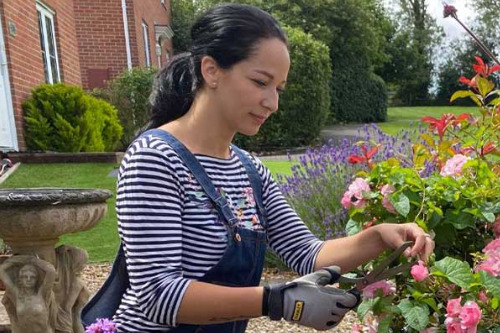There’s no doubting it – we are a nation of keen gardeners. So, what precautions do we need to take when gardening after a hip or knee replacement?
As well as creating beautiful environments for our home, and growing fruit and veg to maintain a good diet, research has also shown that being active outdoors in the garden is good for general mental and physical health too.
Having a new hip or knee doesn’t mean that you have to give up on your garden. If you take the following advice from our physiotherapy team, both you and your garden will thrive.

Wellsoon private healthcare
Wellsoon is a service from Practice Plus Group that provides a range of treatments for patients paying for themselves or paying by private medical insurance. With no hidden costs, you’ll pay less than you might think and be back to your best sooner than you thought.
- £95 consultation within 1 to 2 weeks* – includes x-ray, bloods and swabs
- Surgery in just 4 to 6 weeks*
- Experts in hips, knees, eyes, hernias and more
- Pay for yourself or via health insurance
- 0% finance options available

Can I still do gardening after my hip replacement?
Yes, you can! It’s perfectly possible to return to work in your garden a few months after hip or knee surgery. You just have to take it carefully and follow your healthcare provider’s advice.
How soon can I do gardening after hip replacement?
Typically, most people can get back into gardening between three and six months after hip or knee surgery.
Protect your knee joint and hip joint in the garden
Initial tissue healing takes up to three months after joint replacement surgery and so physical activity during this time period is limited to range of motion, stretching and strengthening exercises as advised by your physiotherapist.
Bending after hip replacement surgery
The range of motion is typically limited to 90 degrees of flexion for the first 90 days while tissues are repairing themselves. The maximum potential of the joint and complete healing following a total hip replacement is achieved between one and two years post operatively.
What’s the maximum bend after knee replacement surgery?
Similar to after a hip replacement, the maximum potential of knee flexion and complete healing following a knee replacement is achieved between one and two years after your operation.
Kneeling after a knee replacement
Patients who have had a total knee replacement are allowed to do kneeling only after six months if they are comfortable. Kneeling may never be completely comfortable but should become easier as the knee regains maximum potential in the long term.
Kneeling after a hip replacement
After a hip replacement, many patients can kneel down after completing the precautionary period of three months. The safe way to do this is to perform a single-legged kneel whereby the patient kneels on the knee of the operated side only. This means that the other hip has to bend whilst the operated hip stays extended. The reverse is true after a knee replacement as it may be too painful to kneel on the operated side whereas a single-leg kneel is possible on the opposite side.
How do you get on the floor after a hip replacement?
Always seek the advice of an expert professional on how to get up/down from the ground and bend safely from the hips to assist with weeding and planting.
Reasonable health, motivation, paying attention to body signs (listen to your hip or knee) and time will allow returning to gardening in a relatively shorter period following total hip or knee replacement surgery.
Hip pain after gardening?
If you’re experiencing hip pain, try our hip suitability quiz. It will give you an idea of whether you’d benefit from booking a consultation with one of our hip specialists.
Gardening after a total hip replacement
Resumption of gardening tasks such as shovelling, walking over uneven surfaces, and squatting/bending to the ground will vary from individual to individual depending upon the level of strength prior to hip surgery, level of health, and length of healing time since surgery. Typically, between three and six months most individuals can begin attempting gardening tasks.
Gardening after knee replacement surgery
Regaining the ability to garden comfortably after knee surgery can take a similar time, between three and six months. You may want to avoid rigorous tasks such as shovelling for a little longer. Start slowly and always follow your doctors’ advice to get a better idea of your own personal progress and abilities. As gardening can involve a lot of ground work, you may have to find creative ways to avoid kneeling down until your surgeon gives you the go ahead.
Strengthen your muscles
Usually strengthening exercises should begin eight weeks after hip surgery, and, it is always better to consult your physiotherapist before you start. These exercises develop strength in your muscles which in turn reduces the load on the joint, and prepares you for advanced activities like gardening and so on. By three months after your operation, strength and flexibility will have improved to a point where most patients are able to walk fairly comfortably without an assistive device, get in/out of chairs and drive easily.
Gardening tools and assisted devices
Returning to your garden and flower beds can be assisted with adaptive equipment. A planter’s stool or reacher can enhance your ability to get to the ground when strength and range of motion are limited. Use special knee mats or special knee pads for the work involving kneeling which will reduce the strain on the joint.
A cane can improve your balance walking across the yard or through the garden. In addition, modifying body mechanics can reduce the workload on your new joint – so, when carrying heavy loads such as plants and potting soil, keep them close to your body. Use the ‘unoperated’ leg to apply pressure on a spade or shovel to reduce the stress on the operated side.
Hip replacement surgery at a glance
Dos and don’ts after total hip or knee replacement
Reduce the risk of injury and improve your quality of life after surgery with these tips…
Do:
- Do carry a communication device (mobile phone or pendant alarm) if you live alone
- Do stay hydrated while working in the garden
- Do take short breaks while working for hours in the garden
- Do take it slowly when you first get back into the garden
- Do try some gentle stretches before and after gardening to reduce joint pain
- Do be careful when twisting or bending
- Do wear supportive shoes
- Do use supportive tools such as stools, mats or long handled tools and reachers
- Do contact your doctor if you feel severe pain
- Do check with your surgeon before kneeling.
Don’t:
- Don’t spend hours stooping over flower beds to weed and plant
- Don’t be in one position for a long time as it puts a strain on your whole body. It is good to keep changing your position or do other work, which involves a change of position
- Don’t use tools which are heavy to handle – buy tools which suit your needs and capabilities
- Don’t force your knees or hips into positions that feel uncomfortable
- Don’t be afraid to ask for help in the garden
- Don’t rush the healing process!
Which activities should be avoided after hip replacement?
In the first few weeks and months after surgery, you need to avoid bending more than 90 degrees, crossing your legs and twisting or pivoting at the hip. This means that activities such as driving or exercising are best avoided in the first few weeks after surgery. However, after three to six months (or longer, depending on your own recovery journey), you should be able to carefully return to most of your normal activities.
Lifetime precautions after hip replacement
Aside from ultra long-distance running, there isn’t necessarily any activity that is completely out of bounds after a hip replacement. It all depends on your level of fitness and activity before and after surgery and the advice of your doctor.
As you can see by our advice for cycling after a knee replacement, there are plenty of ways to remain active and healthy with your new hip or knee.
If you think you may need a hip replacement or knee surgery and your GP agrees, you can ask them for a GP referral.


